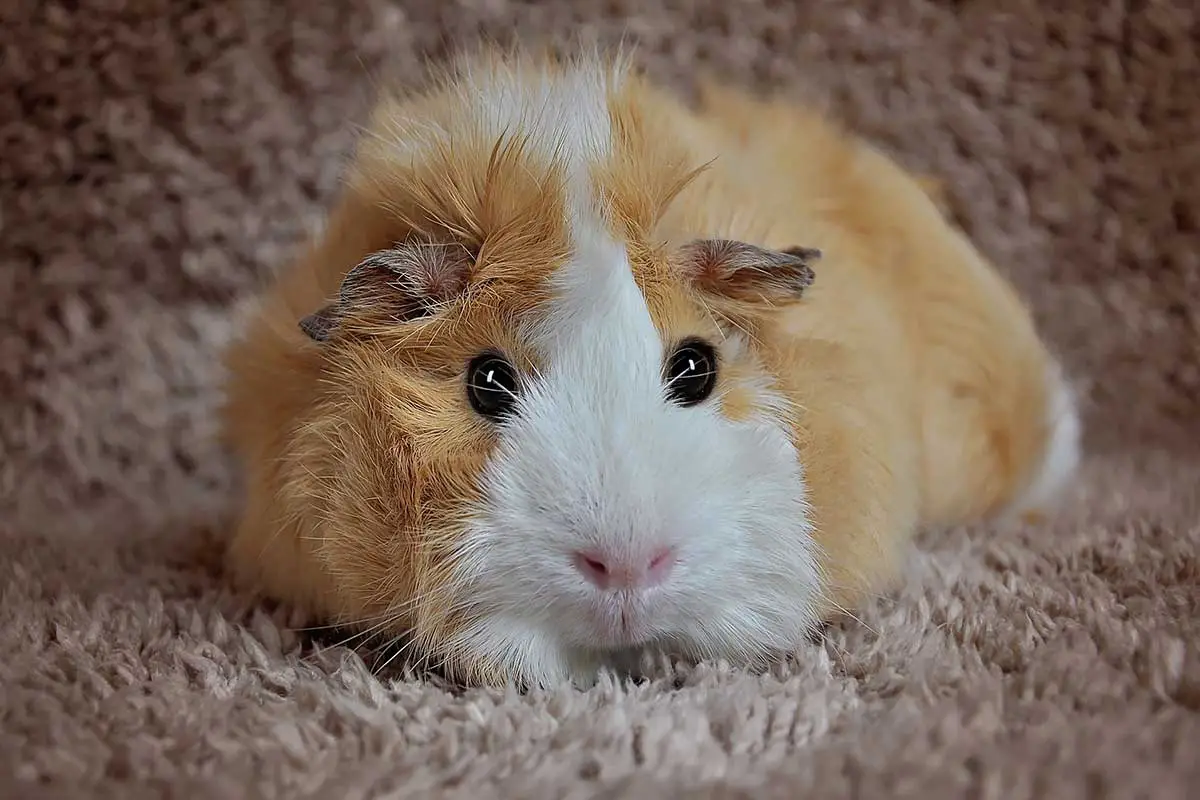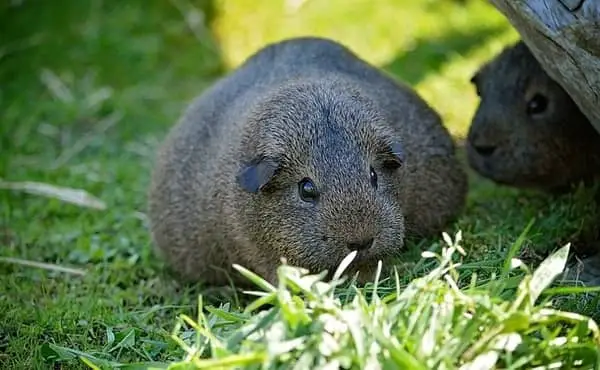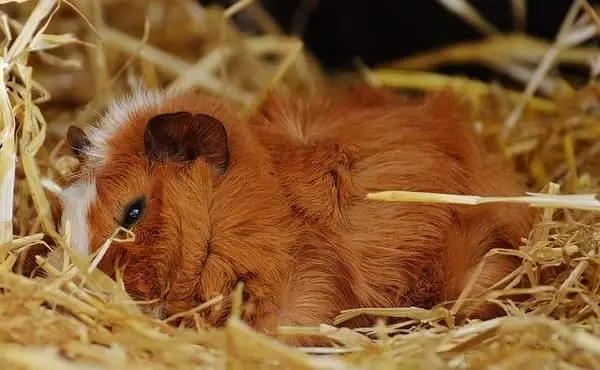Catching an illness or disorder early enough for effective treatment often relies on noticing the slightest abnormalities in your guinea pig’s physical or mental state. It’s always better to be safe than sorry, do your research, and check with your vet if you notice something concerning or unusual—and this goes for nipples too.
So, why are my guinea pig’s nipples sticking out? Their nipples will be more obvious if your guinea pig is a female, pregnant, or nursing. Swollen, crusted, or irregular nipples can also be a sign of infection, cysts, or even cancer.
In this article, we’ll discuss both benign and more troubling reasons a guinea pig’s nipples may be sticking out. For ailments that can cause enlarged nipples, we’ll include an overview of other symptoms and briefly present the most common treatments available for these disorders.
Sex and Hormonal Changes
One reasons your guinea pig’s nipples may appear to be sticking out is simply that she’s a female. Although both male and female guinea pigs have nipples, females’ tend to be larger and more prominent. A female pig’s nipples also may become more prominent as she goes through hormonal changes, becoming sexually mature at about two months old.
Pregnancy
A female guinea pig’s nipples also may become more noticeable in the later stages of pregnancy. This is a normal part of her body preparing to care for newborns. However, this will not be the only sign your guinea pig is pregnant.
By the time nipples become enlarged, a pregnant guinea pig will already be swollen with babies and showing other more obvious symptoms of pregnancy including:
- Enlarged abdomen—at seven weeks pregnant, guinea pigs can weigh up to twice their normal weight.
- Increased appetite and water intake
- Pelvic bones shifting apart in preparation for giving birth
- Movement of fetuses—you will be able to see and feel the babies moving inside the mother.
Is This a Reason for Concern?
Enlarged nipples related to pregnancy are not a reason for concern in themselves. However, you should be aware that pregnancy is difficult for guinea pigs and there are risks involved. If your guinea pig is pregnant, it’s a good idea to check in with your vet to make sure you are giving her the nutrients and supportive care that she needs.
Additionally, if your guinea pig is nursing babies and her nipples become swollen or inflamed, she could be suffering from a painful and dangerous condition called mastitis, which we’ll discuss later in this article.
Ovarian Cysts
Ovarian cysts are another common reason a guinea pig’s nipples may become enlarged. Again, this is a condition that affects only female guinea pigs, but up to 75% of them will develop an ovarian cyst by the time they are five years old.
What Are They?
Ovarian cysts are pockets of fluid that develop near a guinea pig’s ovaries. They appear to be the result of higher estrogen levels associated with the normal reproductive cycle of female pigs. Other symptoms that may appear in conjunction with enlarged nipples include the following.
- Hair loss, especially on the flanks and abdomen
- Crustiness around the nipples
- Enlarged abdomen leading to a pear-shaped appearance
- Infertility
- Lethargy
- Aggression
- Loss of appetite
- Vocalizations
Some guinea pigs will show no symptoms of ovarian cysts besides the swollen appearance of the nipple, and they may not appear to be suffering any distress from them. It’s still a good idea to check with your vet if you suspect your guinea pig may have ovarian cysts.
Although the cyst may not be presently affecting your pig, it could cause issues if left unaddressed and may be accompanied by more serious disorders, including cancer of the uterus.
Are They Treatable?
Ovarian cysts are treatable through hormone therapy or surgery. Hormone therapy is usually the first treatment recommended as surgery is invasive and can be dangerous.
Surgery, however, is the only permanent cure and may be recommended if hormone therapies are ineffective. It’s best to consult a vet with previous experience treating guinea pigs about what to do for a pig with ovarian cysts.
Infections
Enlarged nipples also may indicate that your guinea pig is suffering from an infection in that area. An infected nipple may be full of pus, swollen, red, and possibly oozing or crusted with discharge. Infections are most often caused by an injury or abscess in the nipple area.
Mastitis
Mastitis is an inflammation of the nipples most often seen in nursing females. It’s usually the result of a bacterial infection in the milk glands and may be caused by cuts or scrapes caused by baby guinea pigs’ teeth. Symptoms of mastitis include:
- Swollen, red, and tender nipples
- Skin around nipples feels feverish
- Bluish color to nipples
- Thick, clotted, and or bloody discharge
What Are the Dangers?
Mastitis is a painful and dangerous condition that should be treated as soon as possible. If left untreated, infection may spread to the bloodstream, making your guinea pig very sick and even causing death. Signs of a spreading infection include the following.
- Loss of appetite
- Dehydration
- Depression
- Fever
- Low milk supply
Is it Treatable?
Infections connected to the nipples, including mastitis, are treatable with an antibiotic. If your guinea pig has pups, they will need to be handfed or fed by another lactating female until the mother has fully recovered.
You can hasten healing and help prevent future infections by keeping your guinea pig’s enclosure clean, providing a soft bedding that won’t irritate the pig’s skin, and feeding a highly nutritious diet.
Other Lumps and Swellings
Although only nursing female pigs develop mastitis, both male and female guinea pigs can suffer from abscesses or infections in their nipple area, causing the nipples to swell. Both sexes can also develop sebaceous cysts on the lower part of their body, which can at first be mistaken as enlarged nipples.
Sebaceous Cysts
Sebaceous cysts are benign and usually painless growths that generally occur just under the skin. Although they can be drained or removed, depending on where they are, they may not need to be treated unless they burst. An open cyst will be painful, prone to infection, and does require treatment.
Mammary Cancer
One of the first things that often pops into guinea pig owners’ minds when they feel a lump or enlarged nipple is cancer. Unfortunately, it does occur. Mammary tumors have been found in both male and female guinea pigs and in fact, are the second most common tumor in guinea pigs.
In guinea pigs, this type of cancer will continue to grow and can become quite large, but it does not usually spread to other parts of the guinea pig’s body.
Other Tumors or Cancers
Mammary cancer and other types of tumors are sometimes found in a young animal, but they most commonly occur in older pigs, typically those that are over four years old. Tumors can be surgically removed, although there is a possibility that they will reoccur. An experienced exotic vet will be able to advise you as to the best course of treatment for your particular pig.
What are the Normal Guinea Pig Nipples?
Normal guinea pig nipples are small, round bumps that are evenly spaced along the abdomen. In female guinea pigs, there are typically two rows of nipples, while males may have smaller and less prominent nipples. These nipples are part of the mammary glands and are essential for nursing when the guinea pig becomes a mother. Characteristics of normal guinea pig nipples include their small size, uniform distribution, and color that matches the surrounding skin.
Healthy nipples should not exhibit redness, swelling, or any discharge. Monitoring the normal appearance of guinea pig nipples is crucial for detecting potential issues early on. If there are any unusual changes or signs of discomfort, it is advisable to consult with a veterinarian for proper evaluation and care. Regular observation of your guinea pig’s overall health, including its nipples, is essential for maintaining their well-being.
Conclusion
To sum up, nipple size and shape is not uniform among all guinea pigs—each individual will be different. So, nipples that stick out more on one pig than another is not necessarily cause for concern. In general, a female guinea pig’s nipples will be larger and stick out more than a male’s.
As we have seen, female pigs’ nipples also become enlarged a few weeks before they give birth. But don’t worry too much if you weren’t expecting your pig to be pregnant.
Enlarged nipples are rarely the first clue that your guinea pig is expecting. If there are no other indications that she is, like increased eating and drinking and a growing abdomen, her protruding nipples are probably the result of something else entirely.
Both male and female guinea pigs may suffer from infections, cysts, and cancer. One of these ailments may be to blame if just one or a few of your pig’s nipples are affected.
While the cause may be benign, some of these conditions can quickly grow more serious, so irregular nipples or a sudden change in nipple size is not something to take lightly. It’s best to see a vet to rule out a serious issue and learn how to deal with any lesser issues that may be present.




